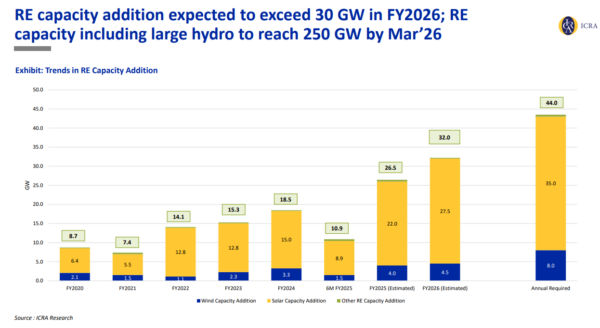
Solar capacity will reach 132 GW by March 2026, with 91 GW installed by September 2024. ICRA said it expects annual solar additions of 22 GW in 2025 and 27.5 GW in 2026.
Senior VP Girishkumar Kadam noted that strong project pipelines and favorable solar module prices will boost renewable additions, especially as inter-state transmission waivers end in June 2025.
ICRA said it expects significant contributions from the rooftop and commercial & industrial (C&I) solar segments to India’s capacity additions, but delays in land acquisition and transmission connectivity remain execution challenges, which could hinder growth, said Kadam.
ICRA said India’s renewable energy capacity will likely increase over the next five years, boosting the share of renewable energy and large hydro in national electricity generation from 21% in 2024 to more than 35% by 2030.
To integrate this growing share, ICRA projects India will need 50 GW of energy storage by 2030, sourced from battery energy storage and pumped storage hydro projects.
“The significant decline seen in the tariffs for BESS projects over the past eight months, driven by the sharp decline in the battery prices, is expected to improve the adoption of the storage projects,” said Kadam.
Central nodal agencies are focusing on awarding renewable energy projects that provide round-the-clock and firm, dispatchable power to reduce the intermittency risk of renewable energy. These projects, often hybrid with energy storage, can help meet demand reliably.
Agencies, along with railways, have completed auctions for nearly 14 GW of such projects. The tariffs remain competitive, with bids ranging from INR 4.0/kWh to INR 5.0/kWh, compared to over INR 6.0/kWh for coal-based projects. ICRA noted these projects will face merchant market tariffs due to oversizing and expected surplus power generation.